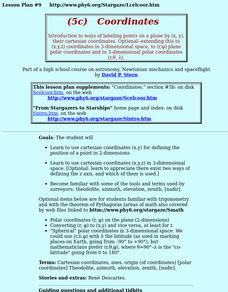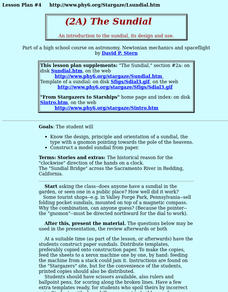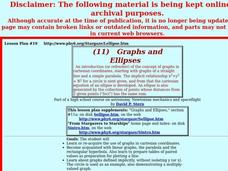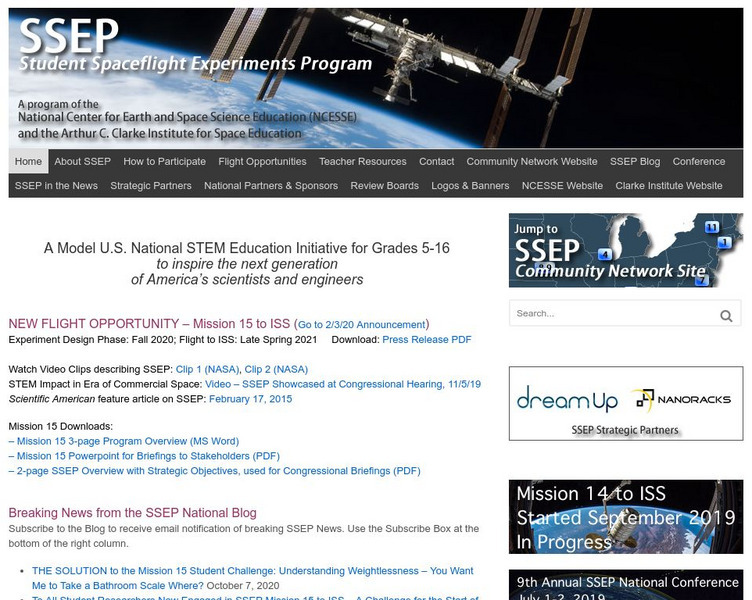Curated OER
How Distant Is The Moon?
Students discover how Aristarchus, a Greek astronomer around 230 BC, used a simple observation of the eclipse of the Moon, plus clever reasoning, to deduce the distance of the Moon. They practice the same calculation technique.
Curated OER
Parallax
Students discover how astronomers used the diameter of the Earth's orbit around the Sun as a baseline for estimating the distance of some stars, and the meaning of "Parsec" and "light year."
Curated OER
Precession
Students explain how Hipparchus, around 130 BC, used a shift in the predicted location of a lunar eclipse to detect a slight shift in the path of the Sun around the sky. They examine the elliptical orbit in which the Earth travels around...
Curated OER
Coordinates
High schoolers use cartesian coordinates (x,y,z) in 3-dimensional space. [Optional: appreciate there exist two ways of defining the z axis, and which of them is used.] They become familiar with the tools and terms used by surveyors.
Curated OER
Navigation
Students study the basic methods for finding one's position on Earth. Latitude can be deduced from the height above the horizon of the pole star or of the noontime Sun, while longitude requires an accurate clock giving universal time.
Curated OER
The Sundial
Students explain the design, principle and orientation of a sundial, the type with a gnomon pointing towards the pole of the heavens. They construct a model sundial from paper.
Curated OER
Stargazers And Skywatchers
Young scholars recognize the daily motion of the Sun across the sky, defining the main directions of east, west, south and north. They see how the first calendars were based on changes in the Sun's noontime elevation, and on locations of...
Curated OER
Stargazers and Skywatchers
High schoolers are introduced to the apparent motion of the Sun across the sky and the way it changes in summer and winter.
Curated OER
The Path of the Sun, the Ecliptic
High schoolers are introduced to the ecliptic, the zodiac and the apparent motions of the Sun, Moon and planets across the sky.
Curated OER
The Discovery of the Solar System
Students explain the observed motion of the planets. The inner ones move back-and-forth across the position of the Sun, while the outer ones usually advance in one direction, but with occasional temporary reversals known as "retrograde...
Curated OER
Stargazers and Skywatchers
Students observe the daily motions of the sun and relate them to the functions of a sundial. They determine the locations of sunrises and sunsets and determine how the elevation of the sun effects temperature.
Curated OER
The Path of the Sun: The Ecliptic
Pupils investigate the celestial sphere and the paths it takes in the solar system.
Curated OER
Finding the Pole Star
Students study the constellations fo the Big Dipper and Cassiopeia and their use in finding the Pole Star. They realize that other celestial objects--Sun, Moon and planets--share the rotation (and hence rise and set), even though their...
Curated OER
The Angle of the Sun's Rays
Students study elevation of the Sun above the horizon and the angle of the rays and their heating power.
Curated OER
Accelerated Frames of Reference: Inertial Forces
Pupils examine how when applying the laws of motion to an object in an accelerating frame, using coordinates defined in such frame, one must always add an "inertial force", representing forces caused by the frame's acceleration.
Curated OER
May Earth be Revolving around the Sun?
Ninth graders explore how Aristarchus used the position of the half-full Moon to estimate the distance to the Sun, and how he made a great error, but still figured out that the Sun is much larger than Earth.
Curated OER
Graphs and Ellipses
Students explore linear graphs, the parabola and the rectangular hyperbola.
Curated OER
Kepler's Second Law
Students explore orbital velocities and how they vary along each orbit, according to Kepler's Second Law.
Curated OER
Kepler's Third Law
High schoolers use Kepler's third law to derive the velocity in a circular orbit of any radius, and identify the Earth escape velocity.
Smithsonian Institution
Nat. Air and Space Museum: Pioneers of Flight: Rockets and Dream of Spaceflight
Read about the history of rocketry and the first rocket inventors who laid the initial foundation for the development of the spaceflight industry.
NASA
Nasa: Human Spaceflight Gallery Archive
Search this NASA gallery database for multimedia resources (images, video, audio) from these NASA space programs: the shuttle missions, the International Space Station, and the Mercury, Gemini, Apollo, and Skylab space missions.
NASA
Nasa: Food for Spaceflight Activity
This educator's guide provides teachers with activities to teach students about food during spaceflights. Students will learn about types of food astronauts take on space missions and why these foods are the most suitable for space.
Other
Ncesse: Student Spaceflight Experiments Program
A competition for students in Grades 5 and up, in which they design an experiment that would fly in space under conditions of microgravity. Winners in local competitions are chosen to submit their designs for inclusion in a...
























